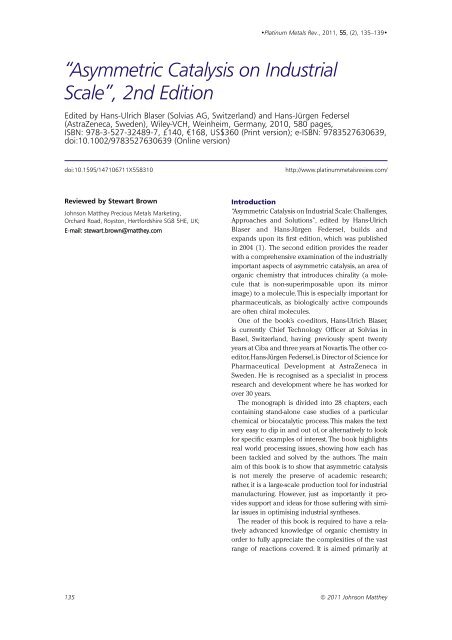Download - Platinum Metals Review
Download - Platinum Metals Review
Download - Platinum Metals Review
You also want an ePaper? Increase the reach of your titles
YUMPU automatically turns print PDFs into web optimized ePapers that Google loves.
•<strong>Platinum</strong> <strong>Metals</strong> Rev., 2011, 55, (2), 135–139•<br />
“Asymmetric Catalysis on Industrial<br />
Scale”, 2nd Edition<br />
Edited by Hans-Ulrich Blaser (Solvias AG, Switzerland) and Hans-Jürgen Federsel<br />
(AstraZeneca, Sweden), Wiley-VCH, Weinheim, Germany, 2010, 580 pages,<br />
ISBN: 978-3-527-32489-7, £140, €168, US$360 (Print version); e-ISBN: 9783527630639,<br />
doi:10.1002/9783527630639 (Online version)<br />
doi:10.1595/147106711X558310<br />
http://www.platinummetalsreview.com/<br />
<strong>Review</strong>ed by Stewart Brown<br />
Johnson Matthey Precious <strong>Metals</strong> Marketing,<br />
Orchard Road, Royston, Hertfordshire SG8 5HE, UK;<br />
E-mail: stewart.brown@matthey.com<br />
Introduction<br />
“Asymmetric Catalysis on Industrial Scale:Challenges,<br />
Approaches and Solutions”, edited by Hans-Ulrich<br />
Blaser and Hans-Jürgen Federsel, builds and<br />
expands upon its first edition, which was published<br />
in 2004 (1). The second edition provides the reader<br />
with a comprehensive examination of the industrially<br />
important aspects of asymmetric catalysis, an area of<br />
organic chemistry that introduces chirality (a molecule<br />
that is non-superimposable upon its mirror<br />
image) to a molecule.This is especially important for<br />
pharmaceuticals, as biologically active compounds<br />
are often chiral molecules.<br />
One of the book’s co-editors, Hans-Ulrich Blaser,<br />
is currently Chief Technology Officer at Solvias in<br />
Basel, Switzerland, having previously spent twenty<br />
years at Ciba and three years at Novartis.The other coeditor,<br />
Hans-Jürgen Federsel, is Director of Science for<br />
Pharmaceutical Development at AstraZeneca in<br />
Sweden. He is recognised as a specialist in process<br />
research and development where he has worked for<br />
over 30 years.<br />
The monograph is divided into 28 chapters, each<br />
containing stand-alone case studies of a particular<br />
chemical or biocatalytic process. This makes the text<br />
very easy to dip in and out of, or alternatively to look<br />
for specific examples of interest. The book highlights<br />
real world processing issues, showing how each has<br />
been tackled and solved by the authors. The main<br />
aim of this book is to show that asymmetric catalysis<br />
is not merely the preserve of academic research;<br />
rather, it is a large-scale production tool for industrial<br />
manufacturing. However, just as importantly it provides<br />
support and ideas for those suffering with similar<br />
issues in optimising industrial syntheses.<br />
The reader of this book is required to have a relatively<br />
advanced knowledge of organic chemistry in<br />
order to fully appreciate the complexities of the vast<br />
range of reactions covered. It is aimed primarily at<br />
135 © 2011 Johnson Matthey
















